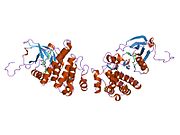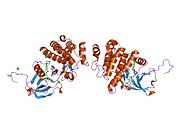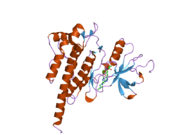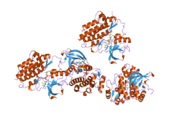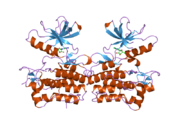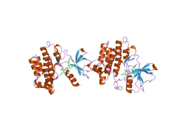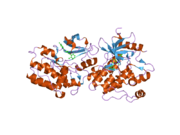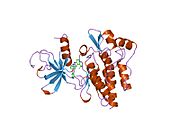ABL2
Tyrosine-protein kinase ABL2 also known as Abelson-related gene (Arg) is an enzyme that in humans is encoded by the ABL2 gene.[5][6]
Function
ABL2 is a cytoplasmic tyrosine kinase which is closely related to but distinct from ABL1. The similarity of the proteins includes the tyrosine kinase domains and extends amino-terminal to include the SH2 and SH3 domains. ABL2 is expressed in both normal and tumor cells. The ABL2 gene product is expressed as two variants bearing different amino termini, both approximately 12-kb in length.[6]
Interactions
ABL2 has been shown to interact with three proteins: Abl gene,[7] catalase,[8] and SORBS2.[9] The protein Abl gene is also known as abelson murine leukemia viral oncogene homolog 1 and is a protein that is encoded by the human ABL1 gene.[10] Catalase is a common enzyme that catalyzes the decomposition of hydrogen peroxide to water and oxygen.[11] SORBS2 is also known as Sorbin and SH3 domain-containing protein 2 and is a protein encoded by the SORBS2 gene in humans.[6][9][12]
References
- ^ a b c GRCh38: Ensembl release 89: ENSG00000143322 – Ensembl, May 2017
- ^ a b c GRCm38: Ensembl release 89: ENSMUSG00000026596 – Ensembl, May 2017
- ^ "Human PubMed Reference:". National Center for Biotechnology Information, U.S. National Library of Medicine.
- ^ "Mouse PubMed Reference:". National Center for Biotechnology Information, U.S. National Library of Medicine.
- ^ Kruh GD, King CR, Kraus MH, Popescu NC, Amsbaugh SC, McBride WO, Aaronson SA (Jan 1987). "A novel human gene closely related to the abl proto-oncogene". Science. 234 (4783): 1545–8. doi:10.1126/science.3787260. PMID 3787260.
- ^ a b c "Entrez Gene: ABL2 v-abl Abelson murine leukemia viral oncogene homolog 2 (arg, Abelson-related gene)".
- ^ Cao C, Leng Y, Li C, Kufe D (April 2003). "Functional interaction between the c-Abl and Arg protein-tyrosine kinases in the oxidative stress response". J. Biol. Chem. 278 (15): 12961–7. doi:10.1074/jbc.M300058200. PMID 12569093.
{{cite journal}}: CS1 maint: unflagged free DOI (link) - ^ Cao C, Leng Y, Kufe D (August 2003). "Catalase activity is regulated by c-Abl and Arg in the oxidative stress response". J. Biol. Chem. 278 (32): 29667–75. doi:10.1074/jbc.M301292200. PMID 12777400.
{{cite journal}}: CS1 maint: unflagged free DOI (link) - ^ a b Wang B, Golemis EA, Kruh GD (July 1997). "ArgBP2, a multiple Src homology 3 domain-containing, Arg/Abl-interacting protein, is phosphorylated in v-Abl-transformed cells and localized in stress fibers and cardiocyte Z-disks". J. Biol. Chem. 272 (28): 17542–50. doi:10.1074/jbc.272.28.17542. PMID 9211900.
{{cite journal}}: CS1 maint: unflagged free DOI (link) - ^ Szczylik C, Skorski T, Nicolaides NC, Manzella L, Malaguarnera L, Venturelli D, Gewirtz AM, Calabretta B (August 1991). "Selective inhibition of leukemia cell proliferation by BCR-ABL antisense oligodeoxynucleotides". Science. 253 (5019): 562–5. doi:10.1126/science.1857987. PMID 1857987.
- ^ Chelikani P, Fita I, Loewen PC (January 2004). "Diversity of structures and properties among catalases". Cell. Mol. Life Sci. 61 (2): 192–208. doi:10.1007/s00018-003-3206-5. PMID 14745498.
- ^ Nagase T, Ishikawa K, Suyama M, Kikuno R, Miyajima N, Tanaka A, Kotani H, Nomura N, Ohara O (Apr 1999). "Prediction of the coding sequences of unidentified human genes. XI. The complete sequences of 100 new cDNA clones from brain which code for large proteins in vitro". DNA Res. 5 (5): 277–86. doi:10.1093/dnares/5.5.277. PMID 9872452.
Further reading
External links
- Genes,+abl at the U.S. National Library of Medicine Medical Subject Headings (MeSH)
- Abelson+Leukemia+Virus at the U.S. National Library of Medicine Medical Subject Headings (MeSH)
- ABL2 Info with links in the Cell Migration Gateway











